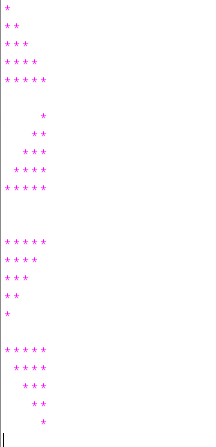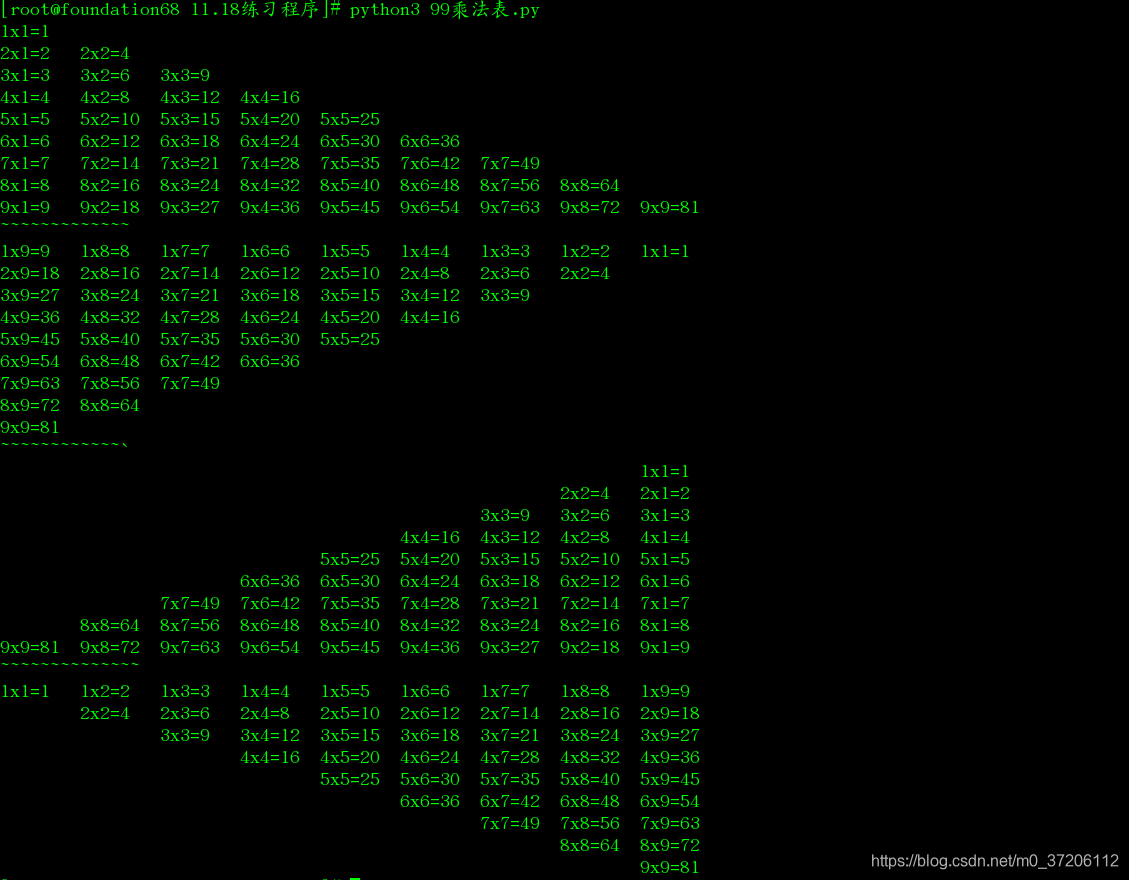Python基礎(linux下)---迴圈語句while,for和字串
for 迴圈的語法:
#for 變數 in range(10):
迴圈需要執行的程式碼
#else:
迴圈結束時需要執行的程式碼
#1+2+3+…+100=
c語言或者java:
sum = 0
for(int i=1;i<=100;i++):
sum = sum + i
print sum
python:
sum = 0
for i in range(1,101):
sum = sum + i
print(sum)
拿出1~10之間的所有偶數
In [6]: range(1,10,2) Out[6]: [1, 3, 5, 7, 9] In [7]: range(1,11,2) Out[7]: [1, 3, 5, 7, 9]
拿出1~10之間的所有偶數
In [8]: range(2,11,2)
Out[8]: [2, 4, 6, 8, 10]
range()函式
range(stop) : 0~stop 1
range(start,stop) : start~stop 1
range(start,stop,step) : start~stop step(步長)
In [1]: range(5) Out[1]: [0, 1, 2, 3, 4] In [2]: range(7) Out[2]: [0, 1, 2, 3, 4, 5, 6] In [3]: help(range) In [4]: range(1,10) Out[4]: [1, 2, 3, 4, 5, 6, 7, 8, 9] In [5]: help(range)
案例:
使用者登陸程式需求:
1.輸入使用者名稱和密碼
2.判斷使用者名稱和密碼是否正確(name = ‘root’,passwd=‘westos’)
3.為了防止暴力破解,登陸僅有三次機會,如果超過三次,程式就報錯
for i in range(3): name=input('使用者名稱:') passwd=input('密碼:') if name=='root' and passwd=='westos': print('登陸成功') break else: print('登入失敗') print('您還剩餘%d次登陸機會' %(2-i)) else: print('登陸機會超過三次,請等待24小時重試!!!!!')

break和continue:
break:跳出整個迴圈,不會再執行迴圈後續的內容
continue:跳出本次迴圈,continue後面的程式碼不再執行,但是還是會繼續迴圈
exit():結束程式的執行
for i in range(10):
if i == 5:
break
print(i)

for i in range(10):
if i == 5:
continue
print(i)

!!!!因為練習題需要先呼叫一些模組,後面模組部分會講到
import os
#死迴圈
while True:
cmd = input('[[email protected]]$')
if cmd:
if cmd == 'exit':
print('logout')
break
print('hello')
else:
print('run %s' %(cmd))
# 執行shell命令
os.system(cmd)
else:
continue
print('hello')

for語句練習:
輸入兩個數值:
求兩個數的最大公約數和最小公倍數.
提示:最小公倍數=(num1*num2)/最大公約數
本例中用到了python3的內建函式min(a,b),輸出結果就是a和b中的最大值
#1.輸入兩個數值
num1 = int(input('Num1:'))
num2 = int(input('Num2:'))
2.找出兩個數中的最小值
min_num = min(num1,num2)
3.最大公約數的範圍1~min_num之間
最大公約數就是num1和num2能整除的最大的數
for i in range(1,min_num+1): #1,2
if num1 % i == 0 and num2 % i ==0:
gys = i
當迴圈結束時存在gys裡的必定是公約數中的最大值
4.最小公倍數
lcm = int((num1*num2)/gys)
print('%s和%s的最大公約數為%s' %(num1,num2,gys))
print('%s和%s的最小公倍數為%s' %(num1,num2,lcm))

range和xrange
python2:
-range(1,5):即刻生成資料,消耗時間並且佔用記憶體
-xrange(1,5):先生成一個xrange物件,使用值的時候才生成資料,才佔用記憶體
python3:
-range(1,5):相當於python2中的xrange
while迴圈
while 條件:
條件滿足時,做的事情1
條件滿足時,做的事情2
1.定義一個整數變數,記錄迴圈次數
i=1
2.開始迴圈
while i<=5:
print (‘hello python’)
# 處理計數器
i += 1
#計算0~100之間的所有偶數累計求和
i = 0
sum = 0
while i <= 100:
if i % 2 ==0:
sum += i
i += 1
print('0~100之間的所有偶數累計求和的結果是 %d' %sum)
#死迴圈
while True:
print('hello python')
while迴圈練習:
輸出下面圖形:

程式碼:
n=1
while n<=5:
l=1
while l<=n:
print('*',end='')
l += 1
print()
n += 1
print('~~~~~~~~~~~~')
n=1
while n<=5:
l=5
while l>=n:
print('*',end='')
l -=1
print()
n += 1
print('~~~~~~~~~~~~')
n=1
while n<=5:
l=1
while l<=5-n:
print(' ',end='')
l += 1
j = 1
while j<=n and j<=5:
print('*',end='')
j +=1
print()
n +=1
print('~~~~~~~~~~')
n=1
while n<=5:
l=1
while l<n:
print(' ',end='')
l+= 1
while l>=n and l<=5:
print('*',end='')
l +=1
print('~~~~~~~~~~')
n=1
while n<=5:
l=1
while l<n:
print(' ',end='')
l+= 1
while l>=n and l<=5:
print('*',end='')
l +=1
print()
n +=1
執行結果:

99乘法表:
i=1
while i<=9:
j=1
while j<=i:
print('{}x{}={}\t'.format(i,j,i*j),end='')
j +=1
print()
i+=1
print('~~~~~~~~~~~~~')
i=1
while i<=9:
j=9
while j>=i:
print('{}x{}={}\t'.format(i,j,i*j),end='')
j -=1
print()
i+=1
print('~~~~~~~~~~~~`')
i=1
while i<=9:
j=9
while j>i:
print('\t',end='')
j -=1
while j<=i and j>0:
print('{}x{}={}\t'.format(i,j,i*j),end='')
j -=1
print()
i +=1
print('~~~~~~~~~~~~~~')
i=1
while i<=9:
j=1
while j<i:
print('\t',end='')
j +=1
while j>=i and j<=9:
print('{}x{}={}\t'.format(i,j,i*j),end='')
j +=1
print()
i +=1
1,1 All

迴圈練習:
#猜數字遊戲
if , while(for), break
1. 系統隨機生成一個1~100的數字;
** 如何隨機生成整型數, 匯入模組random, 執行random.randint(1,100);
2. 使用者總共有5次猜數字的機會;
3. 如果使用者猜測的數字大於系統給出的數字,列印“too big”;
4. 如果使用者猜測的數字小於系統給出的數字,列印"too small";
5. 如果使用者猜測的數字等於系統給出的數字,列印"恭喜中獎100萬",並且退出迴圈;
程式碼:
import random
a=1
num1=random.randint(1,100)
print(num1)
while a<=5:
num=int(input('請任意輸入1個1~100的數:'))
if num>num1:
print('too big')
a +=1
elif num<num1:
print('too small')
a +=1
else:
print('恭喜中獎100萬')
break
else:
print('你的機會用完了!')
為方便測試我們將電腦隨機生成的隨機數打印出來

字串的定義
a = 'hello'
b = "python"
c = """
使用者管理系統
1.新增使用者
2.刪除使用者
3.顯示使用者
"""
print(type(a))
print(type(b))
print(type(c))
print(a)
print(b)
print(c)
#字串常用的轉義符號
"""
\n:換行
\t:一個tab鍵
\"
\'
"""
#列印guido's
#列印"hello guido's python"
print('guido\'s')
print("guido's")
print('"hello guido\'s python"')
print("\"hello guido's python\"")
print('%s\n%s' %(a,b))
print('%s\t%s' %(a,b))
字串的特性
拿出字串的最後一個字元
print(s[-1])
切片
#s[start:end:step] 從start開始,到end-1結束,步長為step(預設是1)
print('~~~~~~~~~~~~~~~~~~~~~~~~~~')
print(s)
print(s[0:3])
print(s[0:4:2])
顯示所有字元
print(s[:])
顯示前3個字元
print(s[:3])
字串倒序輸出
print(s[::-1])
除了第一個字元之外,其他的全部顯示
print(s[1:])
重複
print(s*10)
連線
print('hello '+'world')
成員操作符
print('he' in s)
print('aa' in s)
print('he' not in s)
字串特性的應用
題目要求:
判斷一個整數是否是迴文數。迴文數是指正序(從左向右)和倒序(從右向左)讀都是一樣
的整數。
##示例:
#示例 1:
#輸入: 121
#輸出: true
#示例 2:
#輸入: -121
#輸出: false
#解釋: 從左向右讀, 為 -121 。 從右向左讀, 為 121- 。因此它不是一個迴文數。
#示例 3:
#輸入: 10
#輸出: false
#解釋: 從右向左讀, 為 01 。因此它不是一個迴文數
直接利用python中切片
程式碼:
num=str(input('請輸入一個整數:'))
if num[:]==num[::-1]:
print('true')
else:
print('flase')

字串的開頭和結尾的匹配
#匹配字串的開頭和結尾
filename='hello.logggh'
if filename.endswith('.log'):
print(filename)
else:
print('error file')
url1 = 'file:///mnt'
url2 = 'ftp://172.25.254.250/pub/'
url3 = 'http://172.25.254.250/index.html'
if url3.startswith('http://'):
print('爬取網頁')
else:
print('不能爬取網頁')

字串去掉兩邊的空格
In [1]: s = ' hello'
In [2]: s.strip()
Out[2]: 'hello'
In [3]: s = ' hello '
In [4]: s.strip()
Out[4]: 'hello'
In [5]: s.lstrip()
Out[5]: 'hello '
In [6]: s.rstrip()
Out[6]: ' hello'
In [7]: s = '\nhello '
In [8]: s.strip()
Out[8]: 'hello'
In [9]: s = '\thello '
In [10]: s.strip()
Out[10]: 'hello'
In [11]: s = 'helloh'
In [12]: s.strip('h')
Out[12]: 'ello'
In [13]: s.strip('he')
Out[13]: 'llo'
In [14]: s.lstrip('he')
Out[14]: 'lloh'
In [15]: s.rstrip('he')
Out[15]: 'hello'
In [17]: print('學生管理系統'.center(50,'*'))
**********************學生管理系統**********************
In [18]: print('學生管理系統'.ljust(50,'*'))
學生管理系統********************************************
In [19]: print('學生管理系統'.rjust(50,'*'))
********************************************學生管理系統
字元的搜尋和替換
find:
replace:
count:
In [20]: s = 'hello python,learn python'
In [21]: s.find('python')
Out[21]: 6
In [22]: s.rfind('python')
Out[22]: 19
In [23]: s.replace('python','linux')
Out[23]: 'hello linux,learn linux'
In [24]: s1 = s.replace('python','linux')
In [25]: s1
Out[25]: 'hello linux,learn linux'
In [26]: s
Out[26]: 'hello python,learn python'
In [27]: s.count('python')
Out[27]: 2
In [28]: s.count('p')
Out[28]: 2
In [29]: s.count('i')
Out[29]: 0
字串的分離和拼接
split:
join:
In [30]: ip = '172.25.254.10'
In [31]: ip1 = '1172.25.254.10'
In [32]: ip1.split('.')
Out[32]: ['1172', '25', '254', '10']
In [33]: date = '2018-11-18'
In [34]: date.split('-')
Out[34]: ['2018', '11', '18']
In [35]: date.split('.')
Out[35]: ['2018-11-18']
In [37]: date.replace('-','/')
Out[37]: '2018/11/18'
In [38]: ip = ['1172', '25', '254', '10']
In [39]: ''.join(ip)
Out[39]: '11722525410'
In [40]: ':'.join(ip)
Out[40]: '1172:25:254:10'
In [41]: '*'.join(ip)
Out[41]: '1172*25*254*10'
